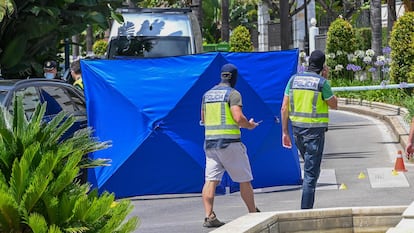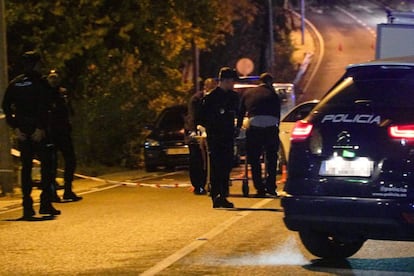Costa del Sol gangland shootings: ‘These people solve everything with guns’
Five incidents involving firearms in the last month underscore the problem of drug-related violence in parts of southern Spain

There are two recent incidents that illustrate what’s going on with all the firearm violence in Spain’s Costa del Sol.
The first one took place early last week in Estepona, in Málaga province. Members of a drug trafficking gang attempted to kidnap the son of a member of a rival gang from Poland. They failed, but the victim was shot in an arm and a leg as a warning.
The second incident occurred this past Saturday in Marbella, where a group of British friends decided to go out early for drinks. The alcohol flowed, a bar fight broke out, and one member of the group was shot twice in the face out in the street. The shooter was one of his own friends, an individual with a police record for trafficking marijuana.
There have been three more incidents involving firearms in Málaga province in the last month alone. “This is getting wild: there are guns around, and very bad people,” says a National Police officer with years of experience in the field.

Both victims survived, but that is not always the case. Marbella, Estepona and other nearby municipalities have become the perfect habitat for numerous drug gangs. These traffickers benefit from the anonymity of the area’s sprawl of residential estates, and they solve their conflicts on the streets, gun in hand. Since 2018, authorities have counted around 20 deaths from score-settling in this corner of Málaga, which has 60 kilometers of coastline.
The autumn of 2019 was particularly bloody, although the two most recent deaths took place in June and August of this year, both in Marbella. Newspaper records show incidents involving explosive devices, kidnappings and point-blank executions. There are also instances of machine-gun fire and assassinations using military-grade weapons such as Kalashnikov assault rifles.
To all this must be added the local violence. On October 6, for instance, a man was shot in the back of the neck during an armed robbery. Miraculously, he survived.
Police experts always give the same answer to the question of what’s going on in Costa del Sol. If the average person is attracted by its sunny weather, quality of life and good connection to other cities, so too are drug traffickers, who are also able to spend their piles of money on maintaining a lavish lifestyle that is less likely to draw attention there.
But a few elements have triggered changes in recent times. The main one is the arrival of new actors. A growing number of organizations see Málaga as the perfect place to conduct their lucrative business which is based on two pillars: hashish trafficking, which is facilitated by Málaga’s proximity to Morocco and a long coastline to drop off the shipments; and growing marijuana, which is helped by a perfect climate and a mountainous landscape that helps conceal plantations.
In both cases, there is a wealth of specialized services available for hire: there are groups whose field of expertise is smuggling drugs ashore; others are adept at car theft, and yet others at fueling the speedboats used to carry the goods. There is also dedicated storage space for keeping drugs, and a wide selection of hitmen who can get rid of problems for a fee.
“These people solve everything with guns,” notes one police officer.
The Spanish Interior Ministry estimates that there are over 100 criminal groups from many countries operating in Costa del Sol. And the number keeps growing: there were half as many in 2013. However, business volume has not kept pace thanks to increased police action, leading to more cases of drug theft among gangs. This in turn is pushing gang members to carry weapons, and resulting in more killings.
This is a powder keg. Let’s hope it doesn’t explodeAnonymous police source
In early 2019, the National Police created a unit dedicated exclusively to score-settling among gangs. This special police group is part of the larger Drugs and Organized Crime Unit (UDYCO).
Meanwhile, the local population carries on, accustomed by now to the situation. It is difficult to find anyone who says they feel afraid or that the area is unsafe, despite the death toll. And local authorities in Estepona and Marbella never tire of saying that both cities are safe, although they do want to see more resources to fight gang violence.
Last week, Estepona mayor José María García Urbano asked central government representatives to “reinforce this part of the province with more security tools.” So did Marbella mayor Ángeles Muñoz last autumn, when the wave of killings was at its peak. Muñoz even proposed setting up a police plan similar to the one started in 2018 in Cádiz’s Campo de Gibraltar area, another hotspot of organized crime. In fact, the greater police presence in Cádiz province is thought to have pushed some of the drug activity to Málaga.
“This works like communicating vessels: if there is more police there, [the gangs] operate more here,” explains an officer stationed in Fuengirola. This summer, numerous drug shipments have been made in the middle of the day, and police operations against drug trafficking are taking place on almost a daily basis.
In late 2004, a seven-year-old child and a 36-year-old man were shot dead inside a Marbella hair salon. The three shooters had been aiming to kill a rival gang member, but missed. The police found 50 bullet shells on the floor. That was the most recent episode of collateral victims from score-settling. The police underscore that hitmen are normally very professional about their job: “They come, they shoot, they get their victim and they disappear,” says one veteran officer.
But there is still a risk for the general population, the police insist. In recent weeks, three people unrelated to any criminal groups sustained minor injuries as a result of gang violence. And around 15 police officers were wounded. “This is a powder keg. Let’s hope it doesn’t explode,” says another officer.
Law of silence
Investigators themselves typically do not know. Police sources explain that there is a law of silence among gangs, who believe in resolving their issues among themselves.
But the killings and warnings typically conceal drug theft between gangs as well as power struggles. Sometimes, somebody will pay with their life for a mistake during a drug operation. And on one occasion this summer, a drug trafficker shot a friend after finding out that he was sleeping with his wife.
English version by Susana Urra.
Tu suscripción se está usando en otro dispositivo
¿Quieres añadir otro usuario a tu suscripción?
Si continúas leyendo en este dispositivo, no se podrá leer en el otro.
FlechaTu suscripción se está usando en otro dispositivo y solo puedes acceder a EL PAÍS desde un dispositivo a la vez.
Si quieres compartir tu cuenta, cambia tu suscripción a la modalidad Premium, así podrás añadir otro usuario. Cada uno accederá con su propia cuenta de email, lo que os permitirá personalizar vuestra experiencia en EL PAÍS.
¿Tienes una suscripción de empresa? Accede aquí para contratar más cuentas.
En el caso de no saber quién está usando tu cuenta, te recomendamos cambiar tu contraseña aquí.
Si decides continuar compartiendo tu cuenta, este mensaje se mostrará en tu dispositivo y en el de la otra persona que está usando tu cuenta de forma indefinida, afectando a tu experiencia de lectura. Puedes consultar aquí los términos y condiciones de la suscripción digital.
More information
Últimas noticias
Most viewed
- Reinhard Genzel, Nobel laureate in physics: ‘One-minute videos will never give you the truth’
- Oona Chaplin: ‘I told James Cameron that I was living in a treehouse and starting a permaculture project with a friend’
- Pablo Escobar’s hippos: A serious environmental problem, 40 years on
- Charles Dubouloz, mountaineering star, retires at 36 with a farewell tour inspired by Walter Bonatti
- Why we lost the habit of sleeping in two segments and how that changed our sense of time









































